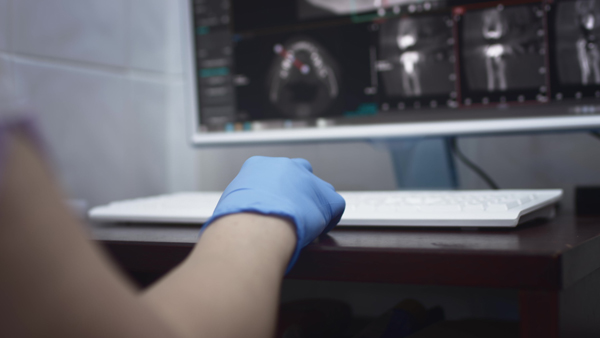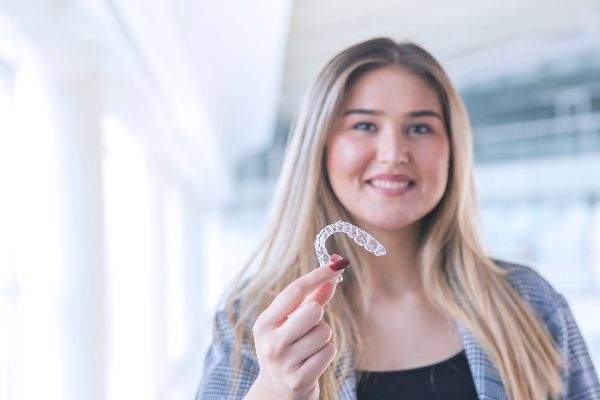The Benefits of Digital X-Rays

Digital X-rays have transformed the way that orthodontists diagnose and monitor jaw misalignments. By offering clearer images with reduced exposure to radiation, digital X-rays provide an advanced, efficient, and safe alternative to traditional film-based diagnostic imaging systems. Orthodontic processes that integrate digital X-rays enhance their quality of care and diagnostic abilities, leading to more efficient orthodontic treatment planning and higher patient satisfaction.
Digital X-rays vs. traditional film X-rays
Traditional film X-rays were first used in 1895. However, orthodontists and other dental professionals have been gradually transitioning to using digital X-rays. Unlike X-rays, which use sensitive photographic film or paper, digital X-rays utilize small tablets to generate images, transmitting those images nearly instantly to a computer.
Conventional X-rays produce a "negative" image on a "bite-wing" film placed in the patient's mouth. This method requires additional equipment for enlargements, resulting in increased film grain and distortion. In contrast, digital X-rays use flat digital sensors connected to a computer with a thin wire, where the resolution depends on the sensor's megapixels. The image can then be enlarged immediately until it is fully pixelated. While both types can suffer from artifacts and errors, most dental professionals agree that digital X-rays offer sharper, cleaner images that are more accurate for interpretation.
The benefits of digital X-rays in orthodontic care
Increased diagnostic accuracy
One of the most significant benefits of digital X-rays is the clarity and detail they provide. High-resolution images allow orthodontists to closely examine bone structure, root positioning, and tooth alignment with greater precision. This improved visualization leads to more accurate diagnoses and better-informed treatment planning. With digital X-rays, orthodontists can detect early signs of impacted teeth, bone loss, or root resorption that may not be visible with traditional X-ray film.
Digital X-rays also allow for real-time manipulation of images. The orthodontic team can immediately adjust brightness, contrast, and zoom features to facilitate better analysis and interpretation. This ability enables a more accurate assessment of orthodontic issues and the identification of risk factors that may impact the patient's orthodontic treatment outcome.
Lower exposure to radiation
Digital X-rays require significantly less radiation than conventional X-rays. For patients undergoing orthodontic treatment, this reduction in radiation exposure is particularly important. Orthodontic care often involves multiple imaging sessions to monitor progress and adjust treatment plans. Using digital X-rays ensures that these repeated scans can be performed safely and with minimal risk to patient health.
The reduced radiation levels also make digital X-rays more appropriate for younger patients. With a considerable percentage of orthodontic patients being children and adolescents, it is important for their developing brains not to be exposed to high levels of radiation. This technology aligns with the principle of ALARA ("as low as reasonably achievable"), allowing dental professionals to minimize both their and their patient's exposure to radiation.
Immediate access to diagnostic images
Unlike traditional film, which requires chemical processing, digital X-rays produce images instantly to a computer. This efficiency enables orthodontists to make quick and accurate decisions. It also reduces the amount of time that patients need to spend in the office.
Immediate access to diagnostic images streamlines the workflow within the orthodontic practice. The orthodontic team can store, retrieve, and share images as needed, which improves coordination between team members and improves overall patient care. Additionally, digital files can be transmitted electronically to other dental specialists, which facilitates collaborative treatment plans and monitoring when necessary.
Improved patient education and communication
Digital X-rays contribute to better communication between orthodontists and their patients. The ability to display images on a monitor allows the orthodontist to visually explain the X-rays findings and recommend the appropriate treatment plan. When patients seeking orthodontic care can see clear and detailed images of their teeth and jaw alignments, they can better understand their condition, as well as the orthodontist's proposed treatment plan.
This visual communication also fosters greater patient engagement and trust. A trusting relationship between an orthodontist and their patient is crucial, especially in complex cases or those that require a long-term commitment. While technical terminology in orthodontic care may be challenging for some patients to understand, accurate and accessible diagnostic imaging provides the necessary context and clarity throughout the treatment process.
Schedule an appointment at our Reston practice
Digital X-rays offer accurate and safe diagnostic images that can help improve your orthodontic treatment. Do you have questions for the Precision Orthodontics & Pediatric Dentistry team? We are here to help. Call our Reston office to learn more about how we use digital X-rays or to schedule an appointment.
Request an appointment here: https://www.orthodonticprecision.com or call Precision Orthodontics & Pediatric Dentistry at (703) 391-8800 for an appointment in our Reston office.
Check out what others are saying about our services on Yelp: Read our Yelp reviews.
Recent Posts
Thinking about getting Invisalign®? Read on to learn some of the benefits of choosing this teeth-straightening treatment. Most people want a beautiful smile, but many people do not want to undergo teeth-straightening treatments that involve conspicuous metal braces. Fortunately, another option called Invisalign involves wearing transparent aligner trays over time to correct tooth misalignment. A…
If you are considering Invisalign® treatment for teeth straightening, you will likely want details about the process. Read on to learn about what happens during and after Invisalign treatment. When you visit the orthodontist for a consultation, they will explain the specifics of what to anticipate during and after treatment. They will also discuss using…
Considering Invisalign®? Read on to learn more about this discreet teeth-straightening treatment. Traditional metal braces are the first thing that comes to our minds when we think about orthodontic treatment. Yet, more and more people are shying away from braces because the metal wires and brackets tend to attract unwanted attention to our teeth. Invisalign…
Invisalign® clear aligner trays are not just for adults; teenagers and some children can also benefit from this treatment system. Many teens prefer Invisalign® over traditional braces because of the numerous advantages it offers, including:Discreet treatment appliancesMore comfort throughout the entire processRemovable trays for improved oral hygieneWhile wearing these trays is easy and relatively effortless,…


